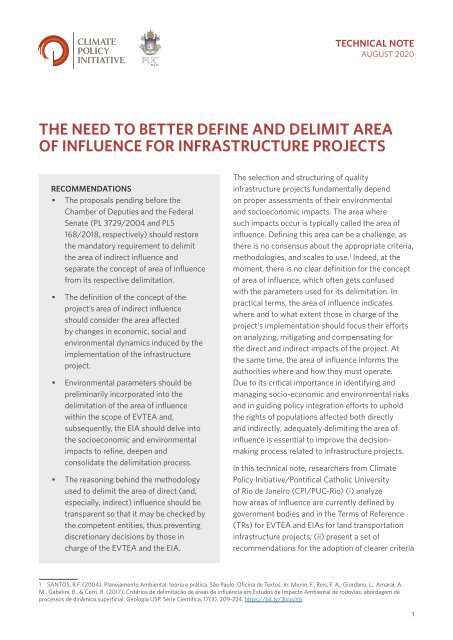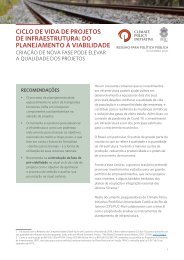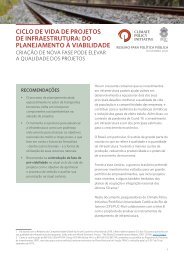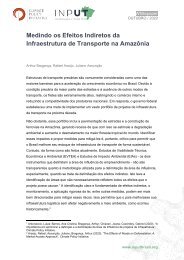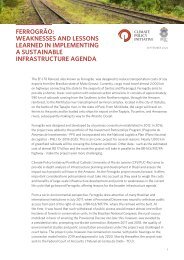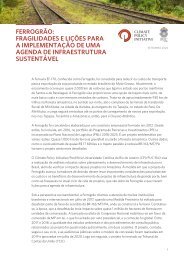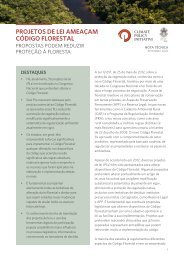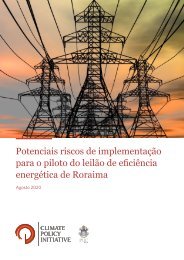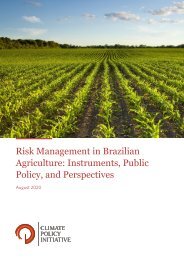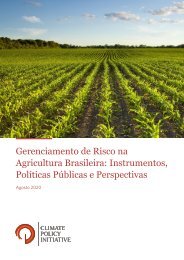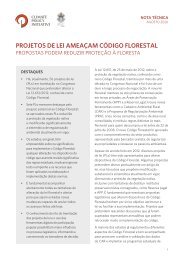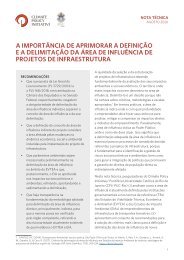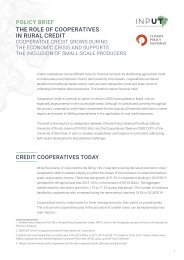The Need to Better Define and Delimit Area of Influence for Infrastructure Projects
You also want an ePaper? Increase the reach of your titles
YUMPU automatically turns print PDFs into web optimized ePapers that Google loves.
TECHNICAL NOTE<br />
AUGUST 2020<br />
THE NEED TO BETTER DEFINE AND DELIMIT AREA<br />
OF INFLUENCE FOR INFRASTRUCTURE PROJECTS<br />
RECOMMENDATIONS<br />
• <strong>The</strong> proposals pending be<strong>for</strong>e the<br />
Chamber <strong>of</strong> Deputies <strong>and</strong> the Federal<br />
Senate (PL 3729/2004 <strong>and</strong> PLS<br />
168/2018, respectively) should res<strong>to</strong>re<br />
the m<strong>and</strong>a<strong>to</strong>ry requirement <strong>to</strong> delimit<br />
the area <strong>of</strong> indirect influence <strong>and</strong><br />
separate the concept <strong>of</strong> area <strong>of</strong> influence<br />
from its respective delimitation.<br />
• <strong>The</strong> definition <strong>of</strong> the concept <strong>of</strong> the<br />
project’s area <strong>of</strong> indirect influence<br />
should consider the area affected<br />
by changes in economic, social <strong>and</strong><br />
environmental dynamics induced by the<br />
implementation <strong>of</strong> the infrastructure<br />
project.<br />
• Environmental parameters should be<br />
preliminarily incorporated in<strong>to</strong> the<br />
delimitation <strong>of</strong> the area <strong>of</strong> influence<br />
within the scope <strong>of</strong> EVTEA <strong>and</strong>,<br />
subsequently, the EIA should delve in<strong>to</strong><br />
the socioeconomic <strong>and</strong> environmental<br />
impacts <strong>to</strong> refine, deepen <strong>and</strong><br />
consolidate the delimitation process.<br />
• <strong>The</strong> reasoning behind the methodology<br />
used <strong>to</strong> delimit the area <strong>of</strong> direct (<strong>and</strong>,<br />
especially, indirect) influence should be<br />
transparent so that it may be checked by<br />
the competent entities, thus preventing<br />
discretionary decisions by those in<br />
charge <strong>of</strong> the EVTEA <strong>and</strong> the EIA.<br />
<strong>The</strong> selection <strong>and</strong> structuring <strong>of</strong> quality<br />
infrastructure projects fundamentally depend<br />
on proper assessments <strong>of</strong> their environmental<br />
<strong>and</strong> socioeconomic impacts. <strong>The</strong> area where<br />
such impacts occur is typically called the area <strong>of</strong><br />
influence. Defining this area can be a challenge, as<br />
there is no consensus about the appropriate criteria,<br />
methodologies, <strong>and</strong> scales <strong>to</strong> use. 1 Indeed, at the<br />
moment, there is no clear definition <strong>for</strong> the concept<br />
<strong>of</strong> area <strong>of</strong> influence, which <strong>of</strong>ten gets confused<br />
with the parameters used <strong>for</strong> its delimitation. In<br />
practical terms, the area <strong>of</strong> influence indicates<br />
where <strong>and</strong> <strong>to</strong> what extent those in charge <strong>of</strong> the<br />
project’s implementation should focus their ef<strong>for</strong>ts<br />
on analyzing, mitigating <strong>and</strong> compensating <strong>for</strong><br />
the direct <strong>and</strong> indirect impacts <strong>of</strong> the project. At<br />
the same time, the area <strong>of</strong> influence in<strong>for</strong>ms the<br />
authorities where <strong>and</strong> how they must operate.<br />
Due <strong>to</strong> its critical importance in identifying <strong>and</strong><br />
managing socio-economic <strong>and</strong> environmental risks<br />
<strong>and</strong> in guiding policy integration ef<strong>for</strong>ts <strong>to</strong> uphold<br />
the rights <strong>of</strong> populations affected both directly<br />
<strong>and</strong> indirectly, adequately delimiting the area <strong>of</strong><br />
influence is essential <strong>to</strong> improve the decisionmaking<br />
process related <strong>to</strong> infrastructure projects.<br />
In this technical note, researchers from Climate<br />
Policy Initiative/Pontifical Catholic University<br />
<strong>of</strong> Rio de Janeiro (CPI/PUC-Rio) (i) analyze<br />
how areas <strong>of</strong> influence are currently defined by<br />
government bodies <strong>and</strong> in the Terms <strong>of</strong> Reference<br />
(TRs) <strong>for</strong> EVTEA <strong>and</strong> EIAs <strong>for</strong> l<strong>and</strong> transportation<br />
infrastructure projects; (ii) present a set <strong>of</strong><br />
recommendations <strong>for</strong> the adoption <strong>of</strong> clearer criteria<br />
1 SANTOS, R.F. (2004). Planejamen<strong>to</strong> Ambiental: teoria e prática. São Paulo: Oficina de Tex<strong>to</strong>s. In: Menin, F., Reis, F. A., Giordano, L., Amaral, A.<br />
M., Gabelini, B., & Cerri, R. (2017). Critérios de delimitação de áreas de influência em Estudos de Impac<strong>to</strong> Ambiental de rodovias: abordagem de<br />
processos de dinâmica superficial. Geologia USP. Série Científica, 17(3), 209-224. https://bit.ly/3hrxvY6.<br />
1
<strong>for</strong> the definition <strong>and</strong> demarcation <strong>of</strong> areas <strong>of</strong> influence <strong>for</strong> new projects, from a perspective that<br />
explicitly incorporates where the direct <strong>and</strong> indirect effects <strong>of</strong> this type <strong>of</strong> undertaking will occur;<br />
<strong>and</strong> (iii) propose a dialogue between the EVTEA <strong>and</strong> the EIA.<br />
In Brazil, the area <strong>of</strong> influence <strong>of</strong> infrastructure projects is currently delimited in two moments:<br />
in the Feasibility Studies (Estudo de Viabilidade Técnica, Econômico e Ambiental - EVTEA), which<br />
aims <strong>to</strong> assess the economic feasibility <strong>of</strong> the project, <strong>and</strong> the Environmental Impact Assessment<br />
(Estudo de Impac<strong>to</strong> Ambiental - EIA), meant <strong>to</strong> evaluate the project’s environmental feasibility.<br />
<strong>The</strong>re is a difference in the objective <strong>and</strong> scope between these two instruments which, in itself,<br />
may lead <strong>to</strong> different delimitations <strong>of</strong> projects’ areas <strong>of</strong> influence. On the other h<strong>and</strong>, both<br />
instruments, in theory, apply <strong>to</strong> the same project, which means that it is reasonable <strong>to</strong> expect<br />
that their areas <strong>of</strong> influence should somehow be related.<br />
Within the scope <strong>of</strong> the EIA, changes <strong>to</strong> determine area <strong>of</strong> influence are currently under<br />
discussion by Brazil’s National Congress. General Environmental Licensing Bill (Legislative<br />
Bill PL 3,729/2004) <strong>and</strong> Senate Bill PLS 168/2018, both aimed at changing environmental<br />
licensing rules, restrict the concept <strong>of</strong> area <strong>of</strong> influence, proposing that it applies only <strong>to</strong> <strong>Area</strong>s<br />
<strong>of</strong> Direct <strong>Influence</strong> (Área de Influência Direta - AID), where only the direct impacts <strong>of</strong> projects<br />
are considered. In current practice, however, terms <strong>of</strong> reference <strong>for</strong> EIAs usually m<strong>and</strong>ate the<br />
establishment <strong>of</strong> both an AID <strong>and</strong> an <strong>Area</strong> <strong>of</strong> Indirect <strong>Influence</strong> (Área de Influência Indireta -<br />
AII) as parameter <strong>of</strong> study. Such proposals <strong>to</strong> restrict the concept <strong>of</strong> area <strong>of</strong> influence would,<br />
there<strong>for</strong>e, preclude the need <strong>to</strong> assess the indirect effects <strong>of</strong> building <strong>and</strong> operating the<br />
projects. As a logical consequence, they also exclude these indirect effects from future socioenvironmental<br />
mitigation <strong>and</strong> compensation programs.<br />
<strong>The</strong> a<strong>for</strong>ementioned legislative bills also draw on the concept <strong>of</strong> area <strong>of</strong> influence <strong>to</strong> determine<br />
the right <strong>to</strong> participate in the decision-making process, both by limiting public hearings<br />
exclusively <strong>to</strong> people located in the areas directly influenced by the project <strong>and</strong> by restricting the<br />
intervention <strong>of</strong> bodies <strong>and</strong> entities from outside the AIDs. 2<br />
DIFFERENT DEFINITIONS USED BY ANTT,<br />
VALEC AND CONAMA<br />
According <strong>to</strong> the Brazilian L<strong>and</strong> Transportation Regula<strong>to</strong>ry Agency (Agência Nacional de<br />
Transportes Terrestres - ANTT), an area <strong>of</strong> influence is “the part <strong>of</strong> a terri<strong>to</strong>ry where the effects <strong>of</strong><br />
the existence <strong>of</strong> a transport <strong>of</strong>fering can be perceived”. Under this definition, ANTT subdivides<br />
the area <strong>of</strong> influence in<strong>to</strong> two parts: (i) direct or nearby, i.e., an area occupied by habitual users <strong>of</strong><br />
transport facilities, <strong>and</strong> (ii) remote, where the indirect effects <strong>of</strong> a transport <strong>of</strong>fering take place. 3<br />
VALEC also classifies areas <strong>of</strong> influence as direct or indirect, but adopts a more comprehensive<br />
definition than that <strong>of</strong> ANTT. According <strong>to</strong> VALEC, an area <strong>of</strong> direct influence is composed <strong>of</strong><br />
geographical units that constitute potential hubs <strong>for</strong> the loading or passing <strong>of</strong> railroads, whereas<br />
an area <strong>of</strong> indirect influence is composed <strong>of</strong> geographical units that will be impacted by new<br />
railroad either by potentially attracting new loads or by diverting the load flow. According <strong>to</strong> the<br />
2 <strong>The</strong> intervening bodies are: FUNAI (National Indigenous Foundation), Palmares Cultural Foundation, IPHAN (National His<strong>to</strong>ric <strong>and</strong> Artistic<br />
Heritage Institute), the Ministry <strong>of</strong> Health, ICMBio (Chico Mendes Institute <strong>for</strong> Biodiversity Conservation) <strong>and</strong> INCRA (National Institute <strong>for</strong><br />
Colonization <strong>and</strong> Agrarian Re<strong>for</strong>m).<br />
3 ANTT Resolution No. 3,054 <strong>of</strong> 03/05/2009.<br />
2
VALEC’s manual, the delimitation <strong>of</strong> areas <strong>of</strong> direct <strong>and</strong> indirect influence must be justified <strong>to</strong><br />
show, unequivocally, the interactions between the railroad <strong>and</strong> the geographical area.<br />
<strong>The</strong>se agencies use the definition <strong>of</strong> areas <strong>of</strong> direct <strong>and</strong> indirect influence interchangeably<br />
with the concept <strong>of</strong> area delimitation. <strong>The</strong>y also believe that different criteria should be taken<br />
in<strong>to</strong> account in the delimitation process, which may cause some confusion, as these are two<br />
au<strong>to</strong>nomous agencies <strong>and</strong> yet both deal with l<strong>and</strong> transportation. <strong>The</strong> definitions also use<br />
certain terms as parameters that are only related with the economic feasibility <strong>of</strong> the project.<br />
However, the EVTEA also has an environmental component, allowing <strong>for</strong> the possible existence<br />
<strong>of</strong> environmental parameters when delimiting areas <strong>of</strong> influence.<br />
<strong>The</strong> National Environment Council (Conselho Nacional do Meio Ambiente - CONAMA), in turn,<br />
provides a general definition stating that the area <strong>of</strong> influence <strong>of</strong> a project is the “geographical<br />
area <strong>to</strong> be directly or indirectly affected by the impacts”. 4 In practice, the terms <strong>of</strong> reference (TRs)<br />
<strong>for</strong> preparing the EIA go further <strong>and</strong> state that the area <strong>of</strong> influence <strong>of</strong> a given project corresponds<br />
<strong>to</strong> the delimitation <strong>of</strong> the geographical area that will be directly affected by the project <strong>and</strong> <strong>to</strong> the<br />
areas under its indirect influence. In this case, it should be noted that the definition <strong>of</strong> the area <strong>of</strong><br />
influence uses the actual delimitation <strong>of</strong> the area.<br />
It is underst<strong>and</strong>able that the definition is linked <strong>to</strong> delimitation - after all, it is a geographical area<br />
that must be identified based on certain criteria so that the socio-economic <strong>and</strong> environmental<br />
impacts <strong>of</strong> a project can be mapped. However, separating the two concepts - “definition” <strong>and</strong><br />
“delimitation” - can make everything clearer - both when <strong>for</strong>mulating the terms <strong>of</strong> reference <strong>for</strong><br />
the EVTEA <strong>and</strong> the EIA, <strong>to</strong> indicate which criteria or methodology should guide the delimitation<br />
<strong>of</strong> the area <strong>of</strong> influence, <strong>and</strong> when determining who will design the studies.<br />
DELIMITATION OF AREAS OF INFLUENCE<br />
IN THE EVTEA AND EIA TERMS OF REFERENCE<br />
<strong>The</strong> area <strong>of</strong> influence is delimited in two moments within the life cycle <strong>of</strong> a project: in the<br />
EVTEA <strong>and</strong> the EIA - i.e., in the phase when l<strong>and</strong> transportation infrastructure projects undergo<br />
feasibility assessments.<br />
Due <strong>to</strong> the nature <strong>of</strong> these studies, it would make sense <strong>for</strong> the EVTEA <strong>to</strong> preliminarily delimit<br />
the area <strong>of</strong> influence <strong>and</strong> then the EIA would delve in<strong>to</strong> the socioeconomic <strong>and</strong> environmental<br />
impacts, thus consolidating the delimitation process. This is not necessarily what happens, not<br />
least because there is no legal obligation <strong>for</strong> the EVTEA <strong>to</strong> be carried out prior <strong>to</strong> the EIA.<br />
Despite the differences between the criteria employed by ANTT <strong>and</strong> VALEC, both consider areas<br />
<strong>of</strong> both direct <strong>and</strong> indirect influence in their respective definitions. In practice, however, the scope<br />
<strong>of</strong> EVTEA is limited <strong>to</strong> the area <strong>of</strong> direct influence <strong>of</strong> l<strong>and</strong> transportation projects. 5 It should also<br />
be noted that the studies do not justify the delimitation <strong>of</strong> the area <strong>of</strong> influence <strong>and</strong>, in the case<br />
<strong>of</strong> railroad projects, contain no indication as <strong>to</strong> whether the in<strong>for</strong>mation <strong>and</strong> data provided in the<br />
VALEC’s manual <strong>for</strong> EVTEA preparation manual were, in fact, heeded. 6<br />
4 CONAMA Resolution No. 01, <strong>of</strong> January 23, 1986.<br />
5 <strong>The</strong> EVTEA <strong>for</strong> the following projects were analyzed: Ferrogrão, Ferronorte (Cuiabá-Santarém), FICO (Por<strong>to</strong> Velho - Vilhena), Norte-Sul<br />
(Açailândia-Palmas), BR-364 (Rondonópolis / MT-Jataí / GO) <strong>and</strong> BR-163 (Sinop / MT-Miritituba / PA)<br />
6 Ibid.<br />
3
In terms <strong>of</strong> environmental licensing, the EIA terms <strong>of</strong> reference deal with areas <strong>of</strong> direct <strong>and</strong><br />
indirect influence according <strong>to</strong> their peculiarities (e.g., if it is an area with indigenous l<strong>and</strong><br />
present) 7 <strong>and</strong> the impacts <strong>to</strong> which they will be subjected (e.g., population growth, increased<br />
service <strong>of</strong>ferings, etc.). As such, the following parameters must be used: the watershed where the<br />
project will be undertaken, the dynamics <strong>of</strong> l<strong>and</strong> use <strong>and</strong> occupation, as well as social indica<strong>to</strong>rs,<br />
predominant ecosystems, <strong>and</strong> indica<strong>to</strong>rs relevant <strong>to</strong> biodiversity conservation in the region<br />
(watersheds, vegetation cover, etc.). It should be noted that not all parameters are objective by<br />
nature, thus making it important <strong>for</strong> the methodology used in delimiting the area <strong>of</strong> influence <strong>to</strong><br />
be explicitly stated in the EIA.<br />
<strong>The</strong> EIA’s terms <strong>of</strong> reference provide <strong>for</strong> three types <strong>of</strong> areas <strong>of</strong> influence delimitation: Directly<br />
Affected <strong>Area</strong>s (Área Diretamente Afetada - ADA), <strong>Area</strong>s <strong>of</strong> Direct <strong>Influence</strong> (Área de Influência<br />
Direta - AID) <strong>and</strong> <strong>Area</strong>s <strong>of</strong> Indirect <strong>Influence</strong> (Área de Influência Indireta - AII):<br />
• ADA: <strong>Area</strong>s that will undergo direct interventions due <strong>to</strong> activities inherent <strong>to</strong> the project<br />
(areas affected by construction, vegetation removal, access routes, stations <strong>and</strong> yards,<br />
support structures, works <strong>of</strong> art, loaned areas, deposits, dumps, etc.).<br />
• AID: <strong>Area</strong>s actually or potentially threatened by the direct impacts <strong>of</strong> the project’s<br />
implementation <strong>and</strong> operation, as well as associated <strong>and</strong> resulting activities. In addition <strong>to</strong><br />
these minimum guidelines, other areas <strong>to</strong> be incorporated or added <strong>to</strong> the <strong>Area</strong> <strong>of</strong> Direct<br />
<strong>Influence</strong> may need <strong>to</strong> be delimited as well, depending on physical, biological, social <strong>and</strong><br />
economic characteristics <strong>and</strong> the specificities <strong>of</strong> the project in question.<br />
• AII: <strong>The</strong> region that will be affected by the indirect impacts <strong>of</strong> the construction project,<br />
considering the physical, biotic <strong>and</strong>, mainly, socioeconomic environments, as related <strong>to</strong><br />
changes in the dynamics <strong>of</strong> l<strong>and</strong> use <strong>and</strong> occupation, in the dynamics <strong>of</strong> urban centers <strong>and</strong><br />
in the flow <strong>and</strong> transport dynamics at the regional level. For the socioeconomic environment<br />
criterion, the AII must cover, at the very least, the terri<strong>to</strong>ries <strong>of</strong> the municipalities that cross<br />
the project.<br />
Within the scope <strong>of</strong> the federal environmental licensing, although the delimitation <strong>of</strong> areas <strong>of</strong><br />
influence is st<strong>and</strong>ardized in the terms <strong>of</strong> reference <strong>of</strong> the EIAs, in practice different studies use<br />
different criteria <strong>and</strong> fail <strong>to</strong> include the rationale behind the delimitation process.<br />
As an example at the federal level, an EIA carried out <strong>for</strong> the Midwest Integration Railroad<br />
(Ferrovia de Integração do Centro-Oeste - FICO, or simply EF 354) determined that the area<br />
<strong>of</strong> direct influence <strong>for</strong> the biotic environment would encompass a radius <strong>of</strong> 5 km on either<br />
side <strong>of</strong> the railroad. For the physical environment, it was 2.5 km on either side, <strong>and</strong> <strong>for</strong> the<br />
socioeconomic environment, it was the <strong>to</strong>tal area <strong>of</strong> the municipalities directly sectioned by the<br />
railroad layout. It also considered a 10km-radius <strong>for</strong> each area <strong>for</strong> archeology purposes <strong>and</strong> 50<br />
km <strong>for</strong> anthropology. When delimiting the area <strong>of</strong> indirect influence, the EIA pooled the physical<br />
<strong>and</strong> biotic aspects <strong>to</strong>gether <strong>and</strong> delimited a 50 km-radius, with 25 km on each side. From a<br />
7 <strong>The</strong> Interministerial Ordinance 060/2015 regulates the participation <strong>of</strong> governmental bodies in the environmental licensing procedure. In<br />
its annex 1, it establishes a radius in the project’s surrounding in which it assumes interference in certain areas, such as indigenous l<strong>and</strong> <strong>and</strong>/<br />
or quilombola communities, <strong>and</strong> requires the participation <strong>of</strong> the governmental bodies responsible <strong>for</strong> managing these areas in the licensing<br />
procedure. This radius may be used, in a practical sense, as a parameter <strong>to</strong> delimit the AID. However, the ordinance only regulates the participation<br />
<strong>of</strong> governmental bodies <strong>for</strong> this purpose. Additionally, the radius only establishes a minimum distance <strong>for</strong> which the participation <strong>of</strong> governmental<br />
bodies in the environmental licensing procedure, however depending on the EIA or other evidence gathered in the environmental licensing procedure<br />
participation could be required within a longer distance. See: TRF-1. Agravo de Instrumen<strong>to</strong>. Ag n°0005755-44.2017.4.01.0000. Rel: Des. Federal<br />
Daniel Paes Ribeiro. e-DJF1 16/02/2017 PAG 706. Available at: https://bit.ly/32QXILO. Accessed on July 17, 2020.<br />
4
socioeconomic perspective, it encompassed the <strong>to</strong>tal area <strong>of</strong> the municipalities located within 10<br />
km <strong>of</strong> the project’s layout.<br />
<strong>The</strong> Ferronorte (EF 364) project, on the other h<strong>and</strong>, used different criteria <strong>to</strong> delimit the<br />
area <strong>of</strong> direct influence. One <strong>of</strong> the EIAs conducted <strong>for</strong> the project concluded that the AID<br />
should be the same <strong>for</strong> the biotic <strong>and</strong> physical environment <strong>and</strong> considered as a parameter<br />
the micro basins that would be crossed by the project, as well as the l<strong>and</strong>scape - especially<br />
<strong>for</strong>est fragments located near the planned route. As <strong>for</strong> the socioeconomic environment, the<br />
EIA considered the two municipalities that would be most affected by the construction <strong>of</strong> the<br />
railroad. When calculating the area <strong>of</strong> indirect influence <strong>for</strong> the physical <strong>and</strong> biotic environment,<br />
the EIA considered a radius <strong>of</strong> 10 km on either side <strong>of</strong> the railroad <strong>and</strong>, <strong>for</strong> the socioeconomic<br />
environment, concluded that all municipalities surrounding the railroad would suffer indirect<br />
effects from the project.<br />
It should be noted that the same type <strong>of</strong> project in two locations had ADAs, AIDs, <strong>and</strong> AIIs<br />
delimited using different criteria, <strong>and</strong> both studies failed <strong>to</strong> transparently explain how these<br />
delimitations had been determined. Granted, differences can be expected given that the projects<br />
are located in different regions, each with its own peculiarities <strong>and</strong> sensibilities. However,<br />
technical rationale is needed <strong>to</strong> justify the delimitation, as the methodological decisions made<br />
should be publicly available.<br />
AREA OF INFLUENCE AND THE MARKET ACCESS APPROACH<br />
Researchers from CPI/PUC-Rio have developed a “market access” methodology that serves<br />
as the first step in delimiting the area <strong>of</strong> influence <strong>of</strong> transportation infrastructure projects <strong>and</strong><br />
computing the socio-environmental impacts <strong>of</strong> their operation. Using operational research<br />
algorithms <strong>to</strong> estimate transport costs <strong>for</strong> all pairs <strong>of</strong> municipalities in the country (<strong>and</strong> between<br />
each municipality <strong>and</strong> its nearest port), the researchers assist decision makers <strong>to</strong> predict which<br />
municipalities will be impacted by a given investment in transport infrastructure <strong>and</strong> measure the<br />
size <strong>of</strong> such impact on an accessibility measure entitled “market access”.<br />
This approach illustrates just how problematic it is <strong>to</strong> define an area <strong>of</strong> influence based solely<br />
on a radius around the project or on a fixed range <strong>of</strong> kilometers along highways or railroads. To<br />
illustrate, consider the definition <strong>of</strong> a road’s area <strong>of</strong> indirect influence. <strong>The</strong> implementation <strong>of</strong><br />
such a project would affect the economic dynamics not only <strong>of</strong> the project’s surrounding areas,<br />
but also <strong>for</strong> all the producers whose businesses will use the project <strong>to</strong> sell <strong>and</strong>/or transport<br />
their products. Where exactly these entrepreneurs are located, in turn, varies between projects,<br />
as it depends on multiple fac<strong>to</strong>rs such as the goods produced in each region <strong>and</strong> pre-existing<br />
transport networks.<br />
Using CPI’s market access approach <strong>to</strong> delimit the EF-170’s (Ferrogrão’s) area <strong>of</strong> influence<br />
illustrates the limitations <strong>of</strong> the criteria commonly used <strong>to</strong> define areas <strong>of</strong> influence in l<strong>and</strong><br />
infrastructure projects. Figure 1 shows the municipalities impacted by changes in the cost <strong>of</strong><br />
transporting agricultural goods <strong>to</strong> the port in a scenario where the railroad is operational. Due<br />
<strong>to</strong> the lack <strong>of</strong> stations <strong>for</strong> long stretches <strong>of</strong> the route, many municipalities it crosses do not<br />
show accessibility improvements. <strong>The</strong> opposite occurs with several municipalities outside the<br />
railroad’s trajec<strong>to</strong>ry that show substantial gains in accessibility derived from the reduced costs<br />
<strong>of</strong> transporting grains <strong>to</strong> the Miritituba terminal in the state <strong>of</strong> Pará (PA). <strong>The</strong> municipalities<br />
affected by the construction are those outlined in the construction plan, usually with simpler<br />
5
<strong>and</strong> more direct identification. <strong>The</strong>se results show how the geography <strong>of</strong> the economic impacts<br />
resulting from the construction <strong>of</strong> EF-170 (Ferrogrão) is quite different from the geography <strong>of</strong> the<br />
project itself. This means that delimiting an area <strong>of</strong> influence simply by applying the ‘distance<br />
from the project’ criterion is unlikely <strong>to</strong> adequately cover the indirect impacts from the change<br />
in economic dynamics brought about by the project. In fact, the use <strong>of</strong> criteria exclusively based<br />
on distance from the project might overburden mitigation <strong>and</strong> compensation actions in the<br />
vicinity <strong>of</strong> the project, while disregarding these types <strong>of</strong> actions in areas farther away from the<br />
project but <strong>for</strong> which economic dynamics are nonetheless greatly affected by it.<br />
This underscores the need <strong>to</strong> establish clearer criteria <strong>for</strong> defining areas <strong>of</strong> influence. <strong>The</strong><br />
concept <strong>of</strong> area <strong>of</strong> influence must be extricated from its delimitation <strong>to</strong> enable a more reliable<br />
characterization <strong>of</strong> the area <strong>of</strong> influence <strong>for</strong> transport infrastructure projects. Especially in the<br />
area <strong>of</strong> indirect influence, it is also important <strong>to</strong> incorporate the influence <strong>of</strong> criteria related <strong>to</strong> the<br />
extent <strong>of</strong> the project’s economic impact in<strong>to</strong> the delimitation process.<br />
Figure 1: Change in the cost <strong>of</strong> transport <strong>to</strong> the port as a result <strong>of</strong> constructing EF-170 (Ferrogrão)<br />
Source: Climate Policy Initiative<br />
A concern with using these criteria is that projects could become even more complex. However,<br />
economic impact estimates are a key input <strong>for</strong> estimating the dem<strong>and</strong> <strong>for</strong> these projects <strong>and</strong>,<br />
as such, are an inherent part <strong>of</strong> a project’s design <strong>and</strong> feasibility studies. An example would<br />
be a road designed <strong>for</strong> a geographical area widely used by producers, who would experience<br />
a reduction in sourcing <strong>and</strong> marketing costs. This means that it is possible <strong>to</strong> use the same<br />
criteria used <strong>to</strong> identify the users <strong>of</strong> the project <strong>to</strong> also determine the locations where its socioenvironmental<br />
impacts are likely <strong>to</strong> occur <strong>and</strong> which may warrant actions by the project manager<br />
<strong>and</strong> the government <strong>to</strong> mitigate.<br />
<strong>The</strong> EF-170 (Ferrogrão) case is a good example <strong>of</strong> the relevance <strong>of</strong> the proposed criteria when<br />
assessing these projects from a cost-benefit st<strong>and</strong>point. <strong>The</strong> EVTEA <strong>for</strong> this project estimates<br />
6
that most <strong>of</strong> the dem<strong>and</strong> <strong>for</strong> the railroad will be from producers in the mid-north region <strong>of</strong> the<br />
state <strong>of</strong> Ma<strong>to</strong> Grosso, many <strong>of</strong> whom are located hundreds <strong>of</strong> kilometers away from the railroad.<br />
This means that the implementation <strong>of</strong> this project will have indirect socio-environmental<br />
impacts on this region, which, due <strong>to</strong> the definition <strong>and</strong> criteria proposed in this technical<br />
note, should be included in its area <strong>of</strong> influence from the very beginning. <strong>The</strong> EVTEA also<br />
includes several parameters about the project itself - such as the location <strong>of</strong> construction sites,<br />
construction time, etc. - that can be used <strong>to</strong> delimit the area <strong>of</strong> direct influence from the outset.<br />
<strong>The</strong> final shape <strong>of</strong> the area <strong>of</strong> influence must benefit from refinements <strong>to</strong> the con<strong>to</strong>ur through<br />
the addition <strong>of</strong> other criteria <strong>to</strong> be determined by law - <strong>for</strong> example, about l<strong>and</strong>s belonging <strong>to</strong><br />
traditional communities or other sensitive areas.<br />
RECOMMENDATIONS FOR DEFINING<br />
AND DELIMITING THE AREA OF INFLUENCE<br />
<strong>The</strong> use <strong>of</strong> more consistent <strong>and</strong> clear criteria <strong>for</strong> delimiting areas <strong>of</strong> influence is key <strong>to</strong> improving<br />
the delimitation process. Currently, the conceptualization <strong>of</strong> the area <strong>of</strong> influence is <strong>of</strong>ten mixed<br />
with its delimitation. To assuage this confusion, the first recommendation <strong>of</strong> this technical<br />
note is that the concept <strong>and</strong> definition <strong>of</strong> area <strong>of</strong> influence be revisited <strong>and</strong> separated from its<br />
delimitation.<br />
A clear definition <strong>of</strong> the concept <strong>of</strong> area <strong>of</strong> influence, facilitates the determination <strong>of</strong> the most<br />
suitable criteria <strong>for</strong> delimiting the area in question. In this sense, the second recommendation <strong>of</strong><br />
this technical note is that one <strong>of</strong> the criteria used <strong>to</strong> define a project’s area <strong>of</strong> influence includes<br />
any area affected by changes <strong>to</strong> its economic, social <strong>and</strong> environmental dynamics caused by<br />
the implementation <strong>of</strong> an infrastructure project. This will avoid the use <strong>of</strong> purely geographical<br />
parameters as mentioned earlier. It is important <strong>to</strong> note that this technical note does not propose<br />
that this be the only criterion used in delimiting areas <strong>of</strong> influence, but rather that it be used as<br />
one <strong>of</strong> several criteria when defining this area.<br />
Once the concept <strong>and</strong> criteria <strong>for</strong> delimiting the area <strong>of</strong> influence <strong>of</strong> l<strong>and</strong> transportation<br />
infrastructure projects have been determined, one must decide when in the project cycle<br />
the area will begin <strong>to</strong> be delimited <strong>and</strong> studied. As such, the third recommendation <strong>of</strong> this<br />
technical note is that environmental impacts be incorporated in<strong>to</strong> the definition <strong>of</strong> the area <strong>of</strong><br />
influence as early as in the EVTEA. This makes conceptual sense, as these impacts affect the<br />
social costs <strong>and</strong> benefits <strong>of</strong> the project <strong>and</strong> thus influence its economic feasibility. It also makes<br />
practical sense, as it allows the EIA <strong>to</strong> refine <strong>and</strong> add further detail <strong>to</strong> an environmental analysis<br />
conducted be<strong>for</strong>eh<strong>and</strong>.<br />
Finally, transparency is essential. Previous sections have shown how the differences in the criteria<br />
used in the definition <strong>and</strong> delimitation <strong>of</strong> areas <strong>of</strong> influence by different agencies <strong>and</strong> at different<br />
stages in the infrastructure project cycle causes significant confusion <strong>and</strong> insecurity. <strong>The</strong>re<strong>for</strong>e,<br />
the fourth recommendation <strong>of</strong> this technical note is that the preparation <strong>of</strong> studies (EVTEA <strong>and</strong>/<br />
or EIA) be based on clear <strong>and</strong> transparent methodologies that can be checked by competent<br />
bodies so as <strong>to</strong> eliminate the discretion project leaders enjoy in the current model.<br />
7
CONCLUSION<br />
Adequately delimiting the area <strong>of</strong> influence is essential <strong>to</strong> the decision-making process related<br />
<strong>to</strong> infrastructure projects, due <strong>to</strong> its critical importance in identifying <strong>and</strong> managing socioeconomic<br />
<strong>and</strong> environmental risks <strong>and</strong> in guiding policy integration ef<strong>for</strong>ts <strong>to</strong> uphold the rights <strong>of</strong><br />
populations affected directly <strong>and</strong> indirectly by the project.<br />
CPI/PUC-Rio’s analysis reveals that at the moment, there is no clear definition <strong>for</strong> the concept<br />
<strong>of</strong> area <strong>of</strong> influence, which <strong>of</strong>ten gets confused with the parameters used <strong>for</strong> its delimitation.<br />
Additionally, the project studies fail <strong>to</strong> provide any justification <strong>for</strong> the way the areas are<br />
delimited, highlighting the need <strong>for</strong> greater transparency in the methodology <strong>and</strong> in the decisionmaking<br />
process itself. EVTEA <strong>and</strong> EIAs <strong>for</strong> the same project may feature completely different<br />
areas <strong>of</strong> influence; the synergy between these studies could be improved.<br />
AUTHORS<br />
JOANA CHIAVARI<br />
Associate Direc<strong>to</strong>r, Climate Law <strong>and</strong> Governance<br />
Climate Policy Initiative/Pontifical Catholic University<br />
<strong>of</strong> Rio de Janeiro (CPI/PUC-Rio)<br />
joana.chiavari@cpiglobal.org<br />
ARTHUR BRAGANÇA<br />
Head <strong>of</strong> Policy Evaluation, Sustainable Agriculture <strong>and</strong><br />
<strong>Infrastructure</strong><br />
Climate Policy Initiative/Pontifical Catholic University<br />
<strong>of</strong> Rio de Janeiro (CPI/PUC-Rio)<br />
arthur.braganca@cpiglobal.org<br />
ANA CRISTINA BARROS<br />
Senior Advisor<br />
Climate Policy Initiative/Pontifical Catholic University<br />
<strong>of</strong> Rio de Janeiro (CPI/PUC-Rio)<br />
acbarros040@gmail.com<br />
LUIZA ANTONACCIO<br />
Legal Analyst, Climate Law <strong>and</strong> Governance<br />
Climate Policy Initiative/Pontifical Catholic University<br />
<strong>of</strong> Rio de Janeiro (CPI/PUC-Rio)<br />
luiza.an<strong>to</strong>naccio@cpiglobal.org<br />
Suggested Citation<br />
ANTONACCIO, Luiza; BARROS, Ana Cristina; BRAGANÇA, Arthur; CHIAVARI, Joana. Technical Note. <strong>The</strong> <strong>Need</strong> <strong>to</strong><br />
<strong>Better</strong> <strong>Define</strong> <strong>and</strong> <strong>Delimit</strong> <strong>Area</strong> <strong>of</strong> <strong>Influence</strong> <strong>for</strong> <strong>Infrastructure</strong> <strong>Projects</strong>. Rio de Janeiro: Climate Policy Initiative, 2020.<br />
AUGUST 2020<br />
Climate Policy Initiative (CPI) is an analysis <strong>and</strong> advisory organization with deep expertise in finance <strong>and</strong> policy. Our mission is <strong>to</strong> help<br />
governments, businesses, <strong>and</strong> financial institutions drive economic growth while addressing climate change. CPI’s Brazil program partners<br />
with the Pontifical Catholic University <strong>of</strong> Rio de Janeiro (PUC-Rio). This infrastructure work is funded by Gordon <strong>and</strong> Betty Moore Foundation.<br />
This publication does not necessarily represent the view <strong>of</strong> our funders <strong>and</strong> partners.<br />
www.climatepolicyinitiative.org<br />
Content licensed under Creative Commons Attribution 4.0 International. <strong>The</strong> texts in this publication may be reproduced in whole<br />
or in part provided that the source <strong>and</strong> the respective authors are cited.<br />
8


